火星 ALPO-Japan Latest

Mars Image 2018/06/03(UT)
阿久津富夫
John Kazanas,Alexey Kasakov,Ioannis A.Bouhras,Paul Maxson,Niall MacNeill
J.Kazanas,Alexey.K,Ioannis,T.Akutsu,P.Maxson,N.MacNeill
解説(安達)/ Comment by Makoto Adachi
1)地上観測を基にした解説(Comments based on images shot on the earth)
ダストストームが発生しているのに、残念ながら観測がなく、様子がつかめない。John Kazanas氏の画像には、まだダストストームは
顔を出していない。Chryse付近の白雲がよく目立っている。南極冠は周辺に小さな凹凸が目立っている。
Ioannis A.Bouhras氏の画像は、ダストストームの出ている地域とは正反対の位置だが、この表面には、影響はまだ出ていない。
Unfortunately there are no observations,although a dust storm has occurred,I can not seem to see. In the image of Mr. John Kazanas,
the dust storm has not appeared yet. White clouds near Chryse are conspicuous. Small irregularities are conspicuous around the SPC.
Mr. Ioannis A. Bouhras' image is exactly opposite to the area where the dust storm comes out,but the influence has not yet come out
on this surface.
(by 3 observations ;reported by Makoto Adachi)
 2)MRO画像を基にした解説(Comment based on the image from MRO)
たった1日の間に、ダストストームの広がりは大きくなってしまった。6月2日の観測のなかったことが非常に残念だ。また、地上観測
もダストストームの西半分しか記録がなく、MROとの観測で、様子が分かった。安達の作った地図ではオレンジ色がダストストームだが、
雲頂の波状の並びを濃いオレンジで書き加えている。ダストストームの進行方向はこの線の垂直方向だろうと思われる。
この姿から見ると、Mare Acidariumのダストストームは南方向に進んでいる。また、Eden方面のダストストームは南東に移動して
いることが認められる。
注意:ダストストームの塊が経度に沿って大きく3つあるが、MROの撮像システムによってできたものの可能性がある。Meridiani
の北側やMargaritifer Sinusの北側のへこみが、それである。
In just one day the spread of the dust storm got bigger. I am very sorry that there was no observation on June 2. In addition,the
ground observation was recorded only in the western half of the dust storm,and it was understood by MRO observation. On the
map made by Adachi,the orange color is a dust storm,but we have added a wave orange of the cloud top with a dark orange. The
direction of travel of the dust storm seems to be the vertical direction of this line. From this perspective,the dust storm of Mare
Acidarium is heading south. Also,it is recognized that the dust storm in the direction of Eden is moving southeast.
Note: There are three masses of dust storms along the longitude,but there is
a possibility that it was made by
the MRO imaging system. That is the dent in the northern part of Meridiani and north of Margaritifer Sinus.
2)MRO画像を基にした解説(Comment based on the image from MRO)
たった1日の間に、ダストストームの広がりは大きくなってしまった。6月2日の観測のなかったことが非常に残念だ。また、地上観測
もダストストームの西半分しか記録がなく、MROとの観測で、様子が分かった。安達の作った地図ではオレンジ色がダストストームだが、
雲頂の波状の並びを濃いオレンジで書き加えている。ダストストームの進行方向はこの線の垂直方向だろうと思われる。
この姿から見ると、Mare Acidariumのダストストームは南方向に進んでいる。また、Eden方面のダストストームは南東に移動して
いることが認められる。
注意:ダストストームの塊が経度に沿って大きく3つあるが、MROの撮像システムによってできたものの可能性がある。Meridiani
の北側やMargaritifer Sinusの北側のへこみが、それである。
In just one day the spread of the dust storm got bigger. I am very sorry that there was no observation on June 2. In addition,the
ground observation was recorded only in the western half of the dust storm,and it was understood by MRO observation. On the
map made by Adachi,the orange color is a dust storm,but we have added a wave orange of the cloud top with a dark orange. The
direction of travel of the dust storm seems to be the vertical direction of this line. From this perspective,the dust storm of Mare
Acidarium is heading south. Also,it is recognized that the dust storm in the direction of Eden is moving southeast.
Note: There are three masses of dust storms along the longitude,but there is
a possibility that it was made by
the MRO imaging system. That is the dent in the northern part of Meridiani and north of Margaritifer Sinus.
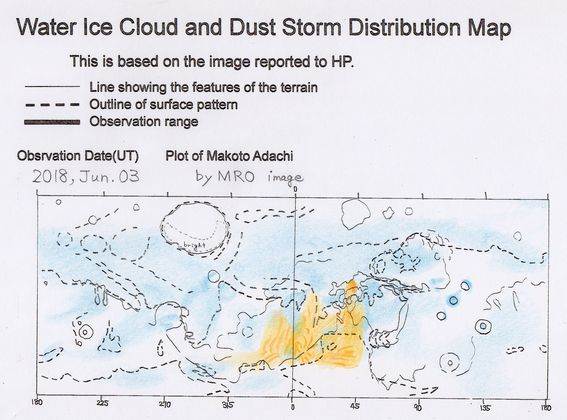 -------------------------------------------------------------------------------------
-------------------------------------------------------------------------------------
Mars taken on June 3,2018 in average conditions showing the Solis Lacus and Valles Marineris areas.
 [John Kazanas,Melbourne Australia]
[John Kazanas,Melbourne Australia]
Mars 2018/06/03 23:58:00(UT),203 mm Maksutov-Cass,Seeing 1/10
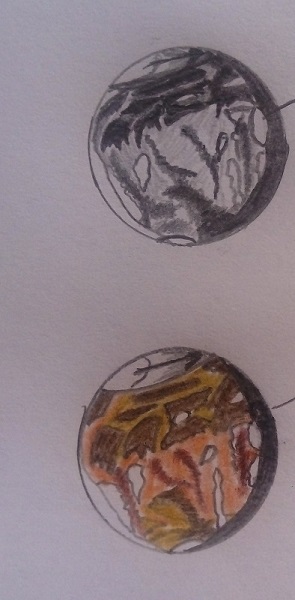 [Alexey Kasakov : [Noginsk,Moscow Region,Russia]
[Alexey Kasakov : [Noginsk,Moscow Region,Russia]
Seeing 7/10 Trans 7/10
 [Ioannis A.Bouhras,Peristeri,Athens;Greece]
[Ioannis A.Bouhras,Peristeri,Athens;Greece]
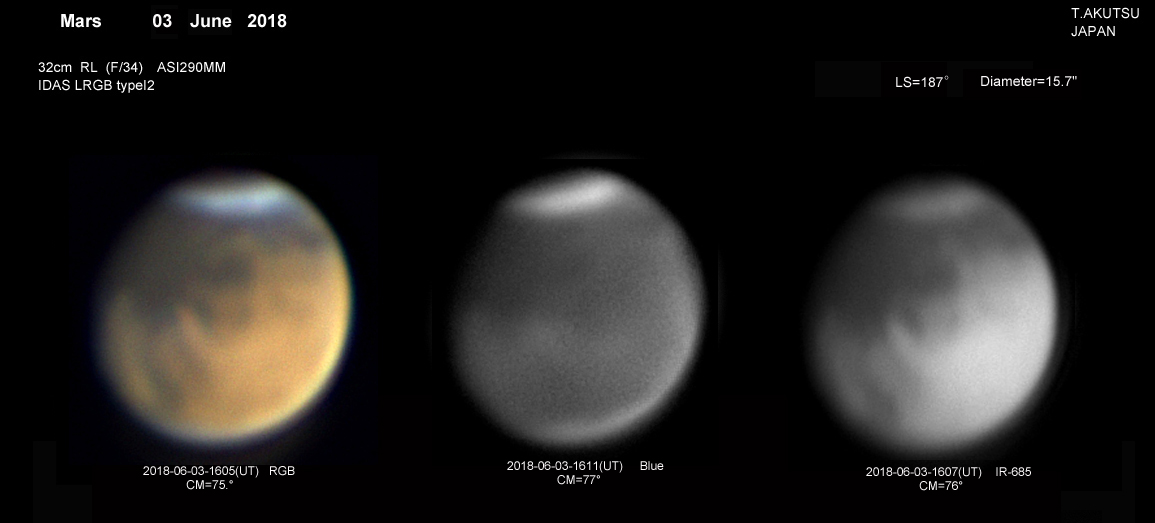 ≪茨城県 : 阿久津富夫≫
≪茨城県 : 阿久津富夫≫
Good IR,below average RGB.
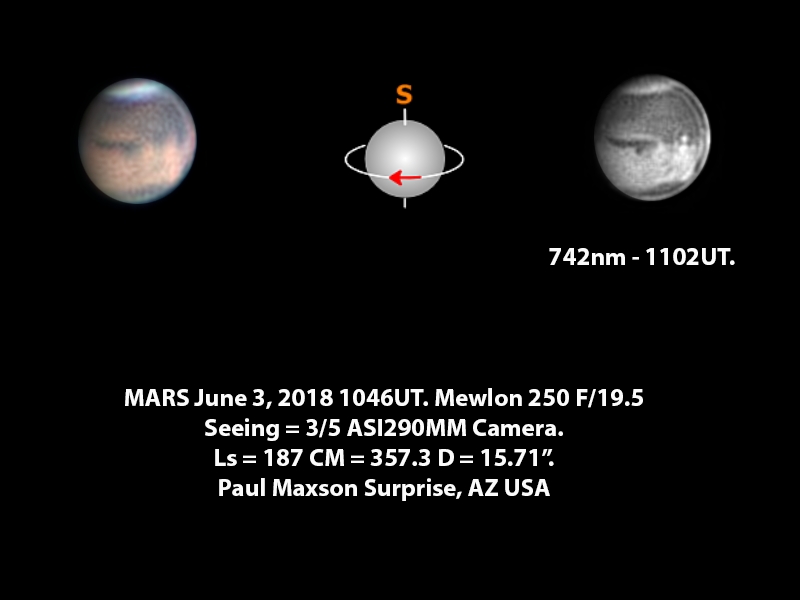 [ Paul Maxson:Surprise,Arizona,United States]
[ Paul Maxson:Surprise,Arizona,United States]
 Mars on 3rd June 2018. 3 RGB runs were made. The first two are approximately an hour apart and the third approximately 2.5 hours later.
These images have been substantially reworked and improved versus the original processing.
What is most interesting is that the first image 16:20UT clearly shows the yellow mass of the spreading dust storm at the terminator on the p side of the planet (top right).
An hour later in the middle image it is still just visible, but has rotated out of view by the third capture.
White orographic clouds around the equatorial region are visible in all three images.
They seem to have moved by the third image or perhaps are lit differently by the Sun.
For example the clouds over the shield volcanoes Arsia and Pavonis Mons, visible in the third image cannot be seen in the first two.
In the first two images, the Valles Marineris is prominent as is Solis Lacus to the south.
The Tharsis Montes are clearly visible in the middle image as 3 blue-grey dots in a row and Olympus Mons is on the f limb rotating into view.
By the third image it was prominently placed at the central meridian. In all three images there is an interesting light purple coloured region just north of the south polar cap.
Mars on 3rd June 2018. 3 RGB runs were made. The first two are approximately an hour apart and the third approximately 2.5 hours later.
These images have been substantially reworked and improved versus the original processing.
What is most interesting is that the first image 16:20UT clearly shows the yellow mass of the spreading dust storm at the terminator on the p side of the planet (top right).
An hour later in the middle image it is still just visible, but has rotated out of view by the third capture.
White orographic clouds around the equatorial region are visible in all three images.
They seem to have moved by the third image or perhaps are lit differently by the Sun.
For example the clouds over the shield volcanoes Arsia and Pavonis Mons, visible in the third image cannot be seen in the first two.
In the first two images, the Valles Marineris is prominent as is Solis Lacus to the south.
The Tharsis Montes are clearly visible in the middle image as 3 blue-grey dots in a row and Olympus Mons is on the f limb rotating into view.
By the third image it was prominently placed at the central meridian. In all three images there is an interesting light purple coloured region just north of the south polar cap.
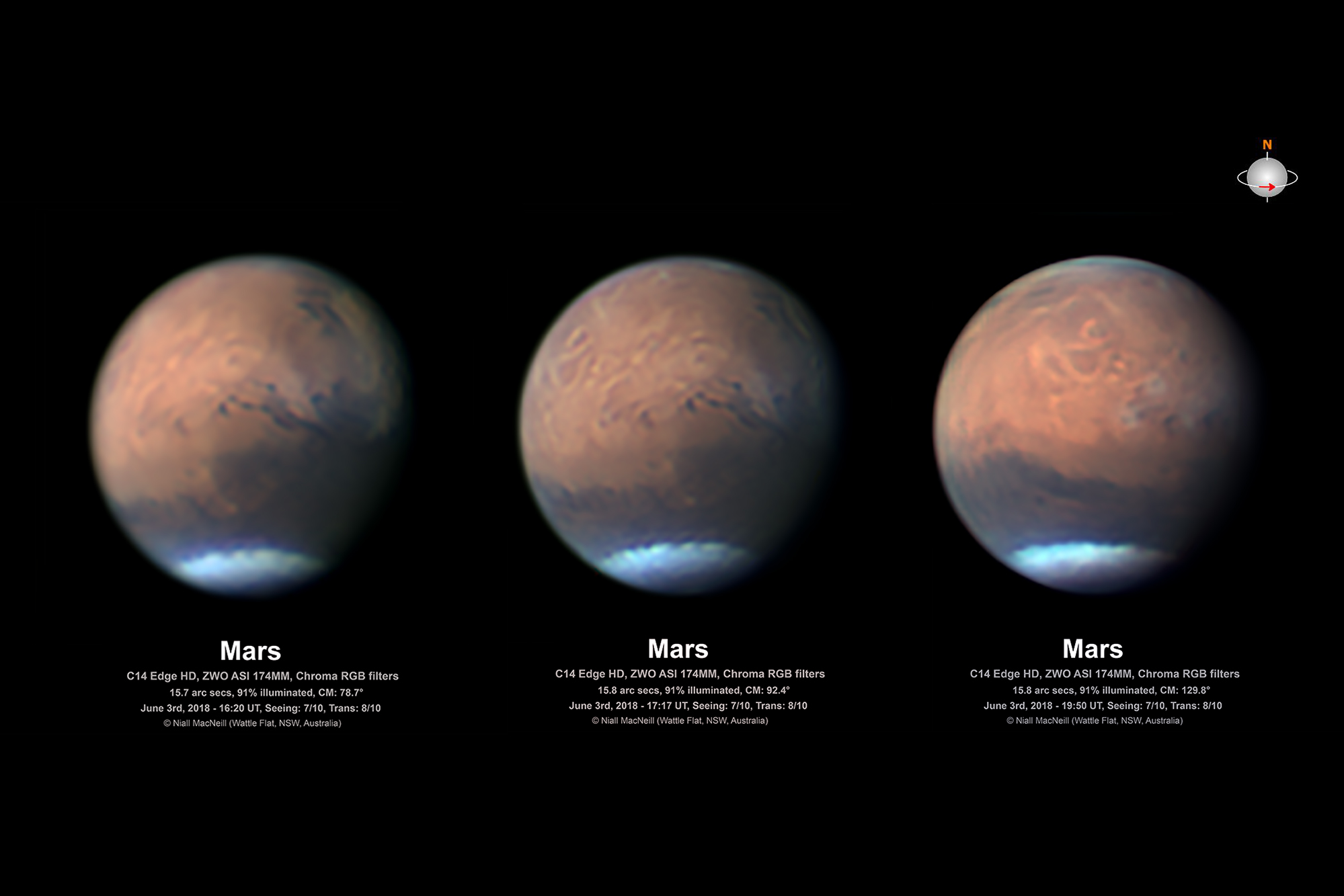 [Niall MacNeill : Wattle Flat,NSW,Australia]
[Niall MacNeill : Wattle Flat,NSW,Australia]


2)MRO画像を基にした解説(Comment based on the image from MRO) たった1日の間に、ダストストームの広がりは大きくなってしまった。6月2日の観測のなかったことが非常に残念だ。また、地上観測 もダストストームの西半分しか記録がなく、MROとの観測で、様子が分かった。安達の作った地図ではオレンジ色がダストストームだが、 雲頂の波状の並びを濃いオレンジで書き加えている。ダストストームの進行方向はこの線の垂直方向だろうと思われる。 この姿から見ると、Mare Acidariumのダストストームは南方向に進んでいる。また、Eden方面のダストストームは南東に移動して いることが認められる。 注意:ダストストームの塊が経度に沿って大きく3つあるが、MROの撮像システムによってできたものの可能性がある。Meridiani の北側やMargaritifer Sinusの北側のへこみが、それである。 In just one day the spread of the dust storm got bigger. I am very sorry that there was no observation on June 2. In addition,the ground observation was recorded only in the western half of the dust storm,and it was understood by MRO observation. On the map made by Adachi,the orange color is a dust storm,but we have added a wave orange of the cloud top with a dark orange. The direction of travel of the dust storm seems to be the vertical direction of this line. From this perspective,the dust storm of Mare Acidarium is heading south. Also,it is recognized that the dust storm in the direction of Eden is moving southeast. Note: There are three masses of dust storms along the longitude,but there is a possibility that it was made by the MRO imaging system. That is the dent in the northern part of Meridiani and north of Margaritifer Sinus.
-------------------------------------------------------------------------------------
[John Kazanas,Melbourne Australia]
[Alexey Kasakov : [Noginsk,Moscow Region,Russia]
[Ioannis A.Bouhras,Peristeri,Athens;Greece]
≪茨城県 : 阿久津富夫≫
[ Paul Maxson:Surprise,Arizona,United States]
Mars on 3rd June 2018. 3 RGB runs were made. The first two are approximately an hour apart and the third approximately 2.5 hours later. These images have been substantially reworked and improved versus the original processing. What is most interesting is that the first image 16:20UT clearly shows the yellow mass of the spreading dust storm at the terminator on the p side of the planet (top right). An hour later in the middle image it is still just visible, but has rotated out of view by the third capture. White orographic clouds around the equatorial region are visible in all three images. They seem to have moved by the third image or perhaps are lit differently by the Sun. For example the clouds over the shield volcanoes Arsia and Pavonis Mons, visible in the third image cannot be seen in the first two. In the first two images, the Valles Marineris is prominent as is Solis Lacus to the south. The Tharsis Montes are clearly visible in the middle image as 3 blue-grey dots in a row and Olympus Mons is on the f limb rotating into view. By the third image it was prominently placed at the central meridian. In all three images there is an interesting light purple coloured region just north of the south polar cap.
[Niall MacNeill : Wattle Flat,NSW,Australia]
 ALPO-Japan Latest
ALPO-Japan Latest

 Mars Section
Mars Section